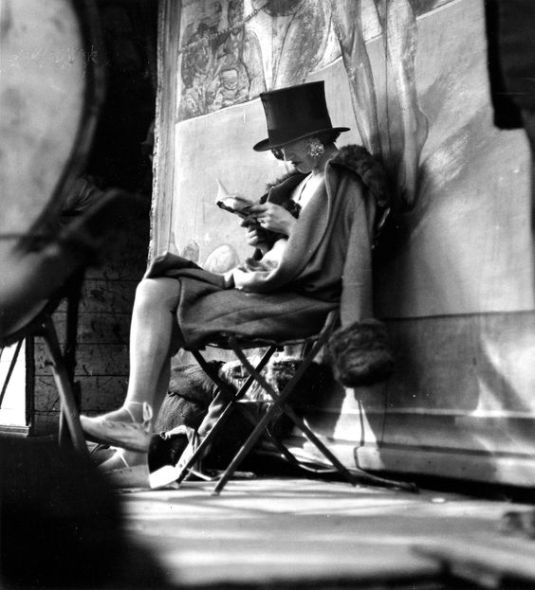
Nancy Cunard (1898-1965), writer, c.1925 by Curtis Moffat via

Nancy Cunard (1898-1965), writer, c.1925 by Curtis Moffat via

Nancy Cunard (1898-1965), writer, c.1925 by Curtis Moffat via

Diary of a Lost Girl is a 1929 silent film directed by Georg Wilhelm Pabst and starring the American silent star Louise Brooks. This was Brooks’ second and last film with Pabst, and like their prior collaboration (1929’s Pandora’s Box), it is considered a classic film. The film was based on the controversial and bestselling novel of the same name, Tagebuch einer Verlorenen (1905) by Margarete Böhme.
Thymian Henning (Louise Brooks), is the innocent, naive daughter of pharmacist Robert Henning. She is puzzled when their housekeeper, Elisabeth, leaves suddenly on the day of Thymian’s confirmation. It turns out that her father got Elisabeth pregnant. Elisabeth’s body is brought to the pharmacy later that day, an apparent suicide by drowning, upsetting Thymian.
Thymian’s father’s assistant Meinert, promises to explain it all to her late that night, but instead takes advantage of her; she gives birth to an illegitimate child. Though Thymian refuses to name the baby’s father, the relatives find out from her diary. They decide that the best solution is for her to marry Meinert. When she refuses because she does not love him, they give the baby to a midwife and send her to a strict reformatory for wayward girls run by a tyrannical woman and her tall, bald assistant.

Louise Brooks for Diary of a Lost Girl directed by George Wilhem Pabst, 1929 via

Louise Brooks for Diary of a Lost Girl directed by George Wilhem Pabst, 1929 via

Louise Brooks for Diary of a Lost Girl directed by George Wilhem Pabst, 1929 via
Californian born Rosa Rolanda (1895-1970, aka Rosemonde Cowan, Rose Rolando, Mrs or Miguel Covarrubias) was a multidisciplinary artist, dancer and choreographer.
In 1916, Rosa Rolanda began her artistic career in New York as a celebrated dancer in Broadway revues. She became involved with the Mexican artist Miguel Covarrubias in 1924, and in the following year the couple traveled to Mexico, where Rolanda began to take photographs.
During the late 1920s or early 1930s, Rolanda experimented with photograms, creating significant series of surrealist self-portraits that may have been influenced by Man Ray, who photographed Rolanda in Paris in 1923.
She probably began painting around 1926. The majority of Rolanda’s canvases depict colorful, folkloric scenes of children and festivals, portraits of friends such as the movie actresses Dolores del Río and María Félix, and self-portraits.
Rolanda and Covarrubias married in 1930, and by 1935 they had permanently settled into his family home in Tizapan El Alto, close to Mexico City.

Rosa Rolanda by Man Ray, 1928 via

Rosa Rolanda in Paris c. 1923, photograph by Man Ray via

Rosa Rolanda by Man Ray 1923 via

Rosa Rolanda in Paris circa 1923 by Man Ray via
André Kertész (1894 – 1985), born Kertész Andor, was a Hungarian-born photographer known for his groundbreaking contributions to photographic composition and the photo essay.
In the early years of his career, his then-unorthodox camera angles and style prevented his work from gaining wider recognition.
Today he is considered one of the seminal figures of photojournalism.

André Kertész, “Latin Quarter,” Paris, 1926 via

André Kertész – A Window on the Quai Voltaire, Paris, 1928 via

André Kertész ”Carnival, Paris (woman reading behind stage)” 1926 Gelatin silver print 10 3/4 x 13 inches © Courtesy Estate of André Kertész/Higher Pictures 2007 via

André Kertész, My Friends at Cafe du Dome, 1928 via

André Kertész Untitled (La fontaine de la Place de la Concorde), Paris, 1925 via
The “Black Bottom” refers to a dance which became popular in the 1920s, originating among African Americans in the rural South. It was adopted by mainstream American culture and became a national craze in the 1920s.
The dance was most famously performed by Ziegfeld Follies star Ann Pennington (1893 – 1971) , who danced the Black Bottom in a Broadway revue put on by Ziegfeld’s rival George White in 1926. The dance was first popularized in New York by the African American show Dinaah that had been staged in Harlem in 1924, after Pennington performed the Black Bottom on Broadway, the dance became a national phenomenon, overtaking The Charleston in popularity.

Ann Pennington teaches Felix the Cat the Black Bottom, 1927 via

Ann Pennington teaches Felix the Cat the Black Bottom, 1927 via

Ann Pennington teaches Felix the Cat the Black Bottom, 1927 via

Ann Pennington teaches Felix the Cat the Black Bottom, 1927 via

Ann Pennington teaches Felix the Cat the Black Bottom, 1927 via

Ann Pennington teaches Felix the Cat the Black Bottom, 1927 via
Helen Kane’s (1904 – 1966) first performance at the Paramount Theater in Times Square proved to be her career’s launching point.
When singing “That’s My Weakness Now”, she interpolated the scat lyrics “boop-boop-a-doop”. This resonated with the flapper culture, and four days later, Helen Kane’s name went up in lights – her signature song was “I Wanna Be Loved By You”.
Kane’s voice and appearance were a likely source for Fleischer Studios animator Grim Natwick when creating Betty Boop.

Helen Kane via

Helen Kane via

Helen Kane via